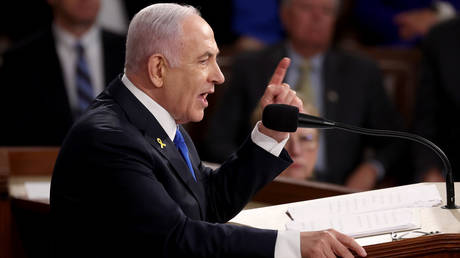ARTICLE AD BOX
BRITISH RAF Typhoon jets obliterated Houthi bases during a meticulously planned overnight blitz by the UK and US on Monday.
The complex military aircraft was used alongside US jets & submarines to bomb the rebels near Yemen’s capital city Sanaa in a 10-hour, 1,500 mile-raid.
 X
X
 Getty
GettyThe expertly planned operation saw the aircraft make their way from Cyprus to Yemen and back in hours, refuelling mid-air as they blitzed the targets.
Incredible footage filmed the moment the bombs hit shows the four Typhoon jets unleashing on the eight Houthi sites after they refused to stop their terrifying attacks on ships in the Red Sea.
A clip shared on social media shows when several blasts go off as the explosions can be seen as glowing amber flashes of light in the distance.
The bombs erupt as they light up the sky across Sanaa in a chilling fashion as smoke clouds quickly form.
In another set of footage, the precise lasers from the bombs can be seen zoning in on their targets before loud, crackling explosions go off.
Timeline of RAF strikes
On the pre-planned operation, four RAF Typhoon jets took off from RAF Akrotiri alongside two Voyager aircraft’s that help to refuel the jets.
They took off from the base in Cyprus at around 5pm on Monday evening and were airborne for several hours as they made there way towards Sanaa, Yemen.
US defence officials said warship and submarine-launched Tomahawk missiles were also sent out alongside the RAF jets.
Because of the long journey the 1,200mph jets had to refuel mid-flight using the Voyager before their long range fuel tanks were able to complete the rest of the mission.
By 9pm the jets had reached their ideal position, five to ten miles away from the eight chosen Houthi targets.
From here a sequence of devastating Paveway IV laser-guided bombs were dropped on the rebels as huge explosions were seen all over the capital of Yemen.
The jets will likely be hovering 35-40,000 feet above sea level as they release the bombs, shooting them horizontally at the chosen targets.
After the explosions had been deployed by the expert team the six aircraft headed back to Cyprus – flying over the Red Sea.
After a second set of refuelling on the route back they landed back at the Akrotiri base at around 3am.
Reactions to the blitz
Houthi rebels warned the UK and US to expect retaliation following the second blitz.
Military spokesman Yahya Saree said: “These attacks will not go unanswered and unpunished.”
The strikes were another dramatic escalation in the crisis that for weeks has been threatening to ignite an all-out war across the Middle East over Israel’s ongoing battle with Hamas.
The Pentagon said Monday’s hit by the united western powers targeted several Houthi bases, including an underground bunker.
A US official told CBS the strikes had “good impact” on targets, understood to have been in the capital Sanaa, al-Dailami military base, near the city of Taizz, and Bayda province.
The UK’s Ministry of Defence said the four RAF Typhoon jets were accompanied by two Voyager tankers and US forces, striking Houthi targets at two military sites near the Sanaa airfield.
These were reportedly Houthi missile storage sites and launchers both crucial for the group’s attack and surveillance capabilities.
UK Prime Minister Rishi Sunak spoke to Parliament today and said: “We must end the illegal sale of arms to the Houthi militia.
“We are going to use the most effective means at our disposal to cut off financial flows to the Houthis. We will keep all other tools at our disposal under review.”
Opposition leader Keir Starmer backed Sunak’s decision to use further force against the Houthi rebels.
He said: “We back this targeted action to reinforce maritime security in the Red Sea. We must stand united and strong.”
Rishi Sunak’s official spokesman said the “strikes have further degraded the Houthis’ ability to attack civilian and military ships, endanger lives and disrupt trade in the Red Sea”.
Before labelling the strikes as “effective”.
We will not hesitate to act in self-defence to protect British lives and interests
Rishi Sunak's official spokesmanThe spokesman continued: “The Prime Minister said that we took this action, together with our allies, because we continue to see an ongoing and imminent threat to UK vessels, and those of our partners, with the Houthis’ launching about 12 attacks on shipping in the Red Sea in the last 10 days.
“While we are not seeking a confrontation, we will not hesitate to act in self-defence to protect British lives and interests.”
Downing Street said there would be a “general debate” for all MPs on the military intervention on Wednesday.
This was the second set of blitz’s on Houthi rebel bases after the first meticulously planned operation started earlier this month.
On January 11, western forces led by the UK and US obliterated 60 military targets in total under the cover of darkness, weakening the Iran-backed terror proxy in Yemen.
Laser-guided Tomahawk missiles and Paveway bombs, 1,200mph fighter jets, Reaper drones and destroyers were used alongside the RAF planes.
It was the first time strikes had been launched against the Houthis following months of brutal Red Sea attacks.
The Ministry of Defence yesterday released dramatic pictures of the RAF Typhoons used to conduct precision strikes on two key Houthi military targets.
 X
X UK Ministry of Defence / Crown 2024
UK Ministry of Defence / Crown 2024.png)
 10 months ago
4
10 months ago
4








 English (US)
English (US)